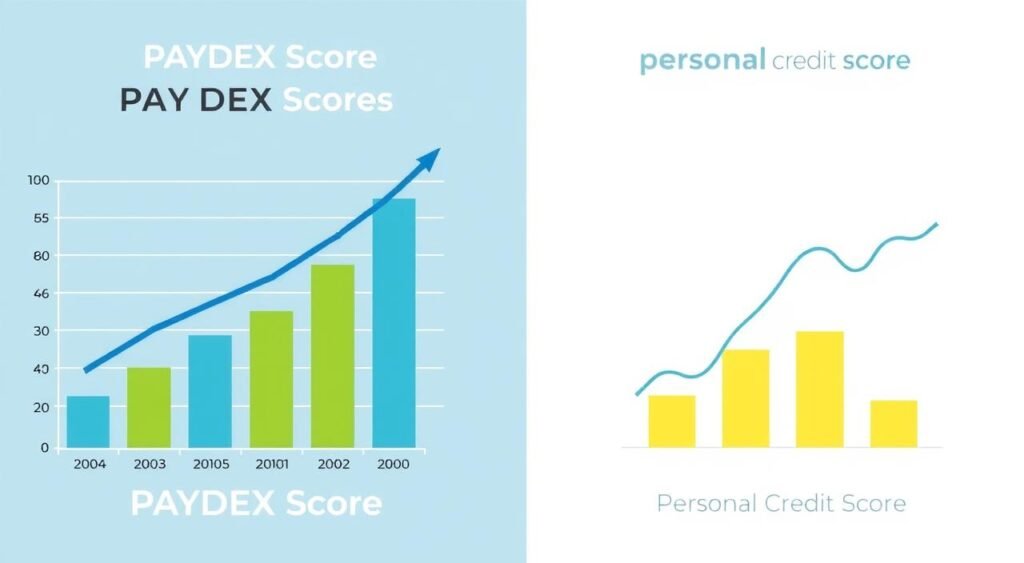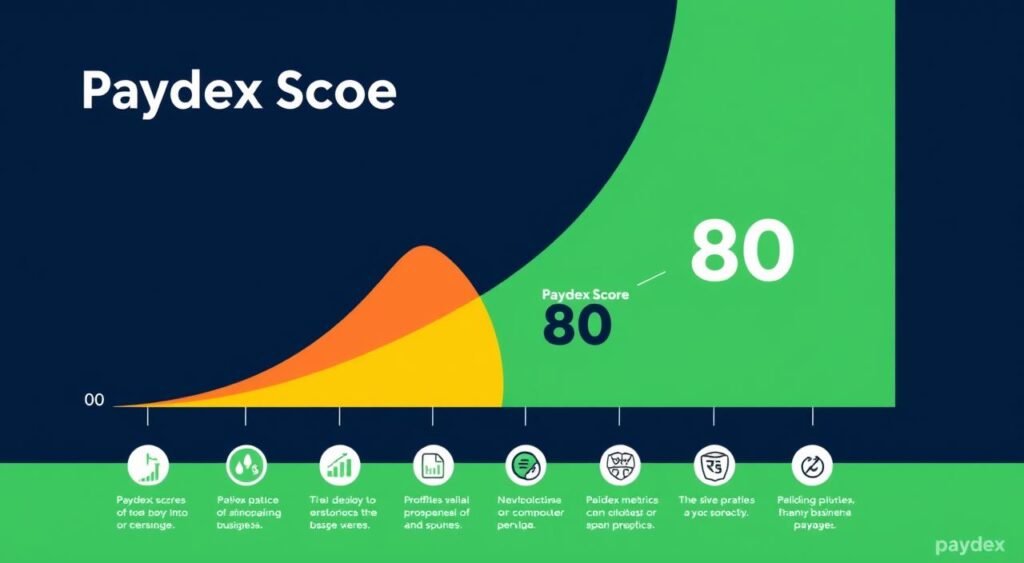Are you a business owner wondering how to unlock better financing options and boost your company’s credibility? The key might lie in a number you’ve never heard of: your PAYDEX score. This powerful metric can make or break your business relationships, but many entrepreneurs overlook its importance. Let’s dive into the world of PAYDEX and discover how it can transform your business prospects.
The PAYDEX score, a unique dollar-weighted numerical indicator, ranges from 0 to 100 and reflects how a firm paid its bills over the past year123. It’s based on trade experiences reported to Dun & Bradstreet by various vendors. A score of 80 or above is considered good, signaling that you pay on time or early, while scores below 50 indicate high risk123.
Your PAYDEX score directly impacts your business’s ability to secure financing for growth. Lenders, suppliers, and potential partners use this score to gauge your financial responsibility. A high score can lead to better credit terms and more favorable business relationships2.
To generate a PAYDEX score, you need at least three experiences from two tradelines. This means two suppliers must report at least three total payments to D&B1. Remember, larger payments carry more weight in your score calculation. For example, paying a $5,000 invoice early has a more significant positive impact than paying a $500 invoice early1.
Key Takeaways
- PAYDEX scores range from 0 to 100, with higher scores indicating better payment behavior
- A score of 80 or above is considered good and can lead to better financing options
- At least three payment experiences from two suppliers are needed to generate a score
- Larger payments have a greater impact on your PAYDEX score
- Improving your PAYDEX score can enhance your business’s credibility and financial opportunities
Understanding the PAYDEX Score
The PAYDEX Score is a crucial tool for business credit building and payment history optimization. This numerical representation, developed by Dun & Bradstreet (D&B), offers valuable insights into a company’s financial health and reliability.
What is a PAYDEX Score?
A PAYDEX Score is a business credit score that ranges from 0 to 100, with higher scores indicating better payment performance45. It serves as a key indicator for lenders, suppliers, and potential business partners when assessing creditworthiness. Scores of 80 and above are considered good, signaling a low risk for creditors46.
How PAYDEX Scores are calculated
To establish a PAYDEX Score, businesses need a D-U-N-S Number and at least three reported trade experiences from two trade references4. The score is dollar-weighted, meaning larger payments have a more significant impact on the overall score46. D&B uses transaction data from the past two years to calculate the score6.
The importance of PAYDEX for businesses
PAYDEX Scores play a vital role in various business decisions. Financial institutions, insurance companies, landlords, suppliers, and vendors use this score to assess risk and make decisions about lending, premium amounts, tenancy, and business engagements6. For effective debt repayment strategies, maintaining a high PAYDEX Score is essential.
A good PAYDEX Score opens doors to better credit terms and business opportunities, making it a valuable asset for any company.
Regular monitoring of your PAYDEX Score allows for prompt identification and resolution of any issues, contributing to stronger business credit building efforts6. By focusing on payment history optimization, businesses can improve their creditworthiness and financial standing in the market.
The PAYDEX Score Range Explained
The PAYDEX score, a crucial measure of financial responsibility, spans from 1 to 1007. This range offers insights into a business’s payment performance, helping vendors assess risk and maintain relationships.
A score of 75 or higher indicates low risk and suggests timely repayments, while scores below 40 are considered poor and signal high late payment risk7. To generate a PAYDEX score, businesses need at least two tradelines with three credit experiences each7.
The pinnacle of the PAYDEX scale is 100, achieved by consistently paying suppliers 30 days in advance7. This score showcases exceptional vendor relationship maintenance and financial responsibility. Conversely, lower scores may require businesses to provide collateral for funding opportunities7.
| PAYDEX Score Range | Interpretation | Bad Rate |
|---|---|---|
| 76 – 100 | Low Risk | 1.7% |
| 51 – 75 | Moderate Risk | 4.4% |
| 26 – 50 | Increased Risk | 10.0% |
| 11 – 25 | High Risk | 19.1% |
| 1 – 10 | Severe Risk | 50.8% |
Lenders and creditors often consider PAYDEX scores when extending credit lines or loans to businesses7. Higher scores improve chances of qualifying for small business loans, underlining the importance of maintaining strong vendor relationships and demonstrating financial responsibility7.
How PAYDEX Differs from Personal Credit Scores
Understanding the difference between PAYDEX and personal credit scores is crucial for business owners. While both aim to assess creditworthiness, they operate on distinct scales and consider different factors.
PAYDEX vs. FICO Score
PAYDEX scores range from 0 to 100, with higher scores indicating better creditworthiness. A score of 80 or above is considered excellent, though scores over 80 are rare8. In contrast, personal FICO scores range from 300 to 8509.
PAYDEX focuses solely on payment history to suppliers and vendors. It requires at least two suppliers with reported payments to generate a score8. FICO scores, on the other hand, consider multiple factors including credit utilization ratio and timely payment habits.
| Aspect | PAYDEX | FICO |
|---|---|---|
| Score Range | 0-100 | 300-850 |
| Focus | Payment History | Multiple Factors |
| Good Score | 80+ | 670+ |
Business Credit vs. Personal Credit
Business credit is separate from personal credit. While PAYDEX is specific to businesses, personal credit scores like FICO apply to individuals. Lenders may consider both when evaluating creditworthiness, depending on the business’s stage and local regulations10.
Other business credit scoring models include Experian and Equifax, with scores ranging up to 76 and 90 respectively10. These models consider factors such as articles of incorporation, business tax filings, and industry statistics.

Maintaining a good business credit score is essential for obtaining favorable loan terms and interest rates. Regular monitoring and timely payments are key to improving your PAYDEX score and overall business credit profile.
The Impact of Payment History on Your PAYDEX Score
Your payment history plays a crucial role in determining your PAYDEX score. This score, ranging from 0 to 100, is a key indicator of your business’s creditworthiness11. A score of 80 or above is considered good and can help you secure better credit terms and financing options11.
Timely payments are essential for maintaining a high PAYDEX score. D&B calculates this score based on your payment history over the past 12 months1112. Paying bills early can significantly boost your score, while late payments can quickly lower it1112.

- Set up automatic payments to ensure timely bill payment
- Keep credit utilization below 30%11
- Build relationships with suppliers who report to credit bureaus11
- Start with small lines of credit and consistently make timely payments11
Implementing effective credit monitoring and debt repayment strategies can help you maintain a strong PAYDEX score. Using AR software can streamline payment management, saving time and resources while fostering better relationships with suppliers11.
| Payment Behavior | Impact on PAYDEX Score |
|---|---|
| Early payments | Significant positive impact |
| On-time payments | Score of 80 |
| Late payments | Quick negative impact |
Remember, your PAYDEX score not only influences business financing but can also affect your overall cost of doing business and open up new partnership opportunities12. Regular credit monitoring and addressing any errors in your business credit report are essential for maintaining a healthy PAYDEX score12.
Strategies for Early Bill Payment
Paying bills early is a smart move for businesses aiming to boost their PAYDEX scores and demonstrate financial responsibility. Let’s explore effective strategies to help you stay ahead of your payment schedule and cultivate timely payment habits.
Setting up automatic payments
Automating your bill payments is a foolproof way to ensure timely payments. Set up recurring transfers from your business account to cover regular expenses. This method not only saves time but also helps avoid late fees and potential credit score drops.
Negotiating payment terms with vendors
Building strong relationships with your vendors can lead to more flexible payment terms. Discuss the possibility of extended payment periods or early payment discounts. Some vendors may offer incentives for early payments, which can improve your cash flow and credit standing13.
Cash flow management techniques
Effective cash flow management is crucial for maintaining timely payments. Implement cash flow forecasting to predict potential shortfalls and prepare accordingly. Consider using invoice factoring services to access working capital when needed, ensuring you can meet payment deadlines consistently.

By adopting these strategies, you can significantly improve your payment practices and boost your PAYDEX score. Remember, consistent early payments demonstrate your business’s financial stability and creditworthiness to potential lenders and partners14.
| Strategy | Benefits | Implementation Tips |
|---|---|---|
| Automatic Payments | Ensures timely payments, saves time | Set up recurring transfers for regular expenses |
| Vendor Negotiations | Flexible terms, potential discounts | Build strong relationships, discuss payment options |
| Cash Flow Management | Predicts shortfalls, maintains liquidity | Use forecasting tools, consider invoice factoring |
Implementing these strategies can lead to improved credit risk analysis and enhanced financial stability for your business14. By focusing on early bill payments and efficient cash flow management, you’re not just boosting your PAYDEX score – you’re setting your business up for long-term success.
Monitoring Your Business Credit Report
Keeping tabs on your business credit report is crucial for maintaining a healthy PAYDEX score. Regular credit monitoring helps you spot inaccuracies, detect identity theft, and identify areas for improvement15.
It’s wise to check your report for at least three months before applying for a loan or credit line. This practice ensures accuracy and gives you time to address any issues15.
- Dun & Bradstreet’s CreditSignal: Offers free PAYDEX Score access for 14 days
- Experian’s Business Credit Advantage: Provides automatic email alerts for inquiries or derogatory filings15
- Third-party sites like Nav: Offer free PAYDEX Score checks
Experian’s CyberAgent technology takes credit monitoring a step further. It actively searches for stolen business information online, sending real-time alerts if your data is compromised15.
Businesses across various industries have found value in credit monitoring services. They’ve used these tools to protect their identity, maintain good credit health, and secure favorable financing15.
Remember, monitoring isn’t just about your own credit. It’s also valuable when evaluating potential business partners or customers. Running simple credit checks can help mitigate risks in your business relationships16.
By staying vigilant with credit monitoring, you’re taking an active role in how to improve your PAYDEX score and overall business credit health.
Credit Risk Assessment and Its Relation to PAYDEX
Credit risk assessment plays a crucial role in business credit building. Lenders use various tools to evaluate a company’s creditworthiness, with PAYDEX being a key component. The PAYDEX score, ranging from 1 to 100, reflects a business’s payment history to vendors and suppliers17.
How lenders use PAYDEX for credit risk assessment
Lenders rely on PAYDEX scores to gauge a company’s reliability in making payments. A score of 80 is considered the benchmark for prompt payment, while scores above 80 indicate early payments18. This information helps lenders determine the level of risk associated with extending credit to a business.
In addition to PAYDEX, lenders consider other D&B scores:
- Failure Score (1-100): Lower numbers indicate higher risk of business failure
- Delinquency Score (1-100): Lower numbers suggest higher risk of severely delinquent payments
- Viability Rating (1-9): Higher numbers signal greater risk of business failure or insolvency18
Other factors in credit risk evaluation
While PAYDEX is important, lenders consider multiple factors when assessing credit risk:
| Factor | Description | Impact on Credit Risk |
|---|---|---|
| Equifax Business Credit Risk Score | Ranges from 101 to 992 | Lower scores indicate higher risk of severe delinquency |
| Experian Business Credit Score | Ranges from 0 to 100 | Divided into risk categories (high, medium, good, excellent) |
| Financial Stability Risk Rating | Ranges from 1 to 5 | Lower ratings suggest lower risk of bankruptcy17 |
Lenders also examine a company’s financial health, industry trends, and business demographics. They may review trade data, bankruptcies, judgments, and tax liens, which remain on business credit reports for varying periods17. This comprehensive approach helps lenders make informed decisions about extending credit to businesses.
Building Strong Vendor Relationships
Strong vendor relationships are key to boosting your PAYDEX score. By focusing on vendor relationship maintenance, you can create a positive payment history. This not only improves your score but also builds trust with your suppliers. Pay your bills early or on time to show reliability. Open communication about payment terms is crucial for maintaining good relationships.
Payment history optimization is vital for a healthy PAYDEX score. Encourage your vendors to report positive payment experiences to Dun & Bradstreet. This helps build a robust credit profile for your business. Remember, your vendors’ stability affects your operations. Nearly 25% of data breaches are due to cyber attacks, which can disrupt your supply chain19. Choose vendors wisely, considering their financial health and ethical practices.
When assessing vendors, consider profiled risk, inherent risk, and residual risk20. Involve stakeholders from different departments in your vendor selection process. This ensures a balanced approach to risk management. For thorough vendor risk assessments, use industry-standard questionnaires or create your own based on frameworks like NIST or ISO20. By building strong vendor relationships and managing risks effectively, you can improve your PAYDEX score and overall business creditworthiness.
FAQ
What is a PAYDEX Score?
How are PAYDEX Scores calculated?
Why is the PAYDEX Score important for businesses?
What is the ideal PAYDEX Score range?
How does PAYDEX differ from personal credit scores like FICO?
How does payment history impact PAYDEX Scores?
What strategies can businesses use to improve PAYDEX Scores?
How can businesses monitor their PAYDEX Scores?
How do lenders use PAYDEX Scores for credit risk assessment?
How can businesses build strong vendor relationships to improve PAYDEX Scores?
Source Links
- PAYDEX Score: The Only Ultimate Guide You Need To Read – https://www.forbes.com/advisor/credit-score/paydex-score/
- Paydex Scores: Your Key to Small Business Financial Success. – https://www.paycron.com/blog/unlocking-financial-success-a-comprehensive-guide-to-paydex-scores-for-small-businesses
- How to Get a PAYDEX Score of 80: The Essential Guide – https://www.unitedcapitalsource.com/blog/paydex-score-80/
- Understanding the Paydex Score – https://www.businessinsider.com/personal-finance/credit-score/what-is-paydex-score
- PAYDEX Business Credit Score: See What Yours Means – https://www.creditsuite.com/blog/decoding-the-paydex-business-credit-score/?srsltid=AfmBOoplKrGGcvtt0gAsaeqAf99qIzsEm_v6v333xjD1Ih3aOe0PbPXs
- What Is A Paydex Score? | Bankrate – https://www.bankrate.com/credit-cards/business/what-is-paydex-score/
- PAYDEX Score: The Dun & Bradstreet Business Credit Rating – https://www.nav.com/business-credit-scores/dun-bradstreet-paydex/
- D&B PAYDEX Score FAQ – Business Credit Score Guide – https://northshoreadvisory.com/business-credit/business-credit-scores/dnb-paydex-score-faqs/
- Business Credit Scores: What They Are & How to Check Them – https://ramp.com/blog/101-guide-to-business-credit-scores
- What is PAYDEX Score | Gaviti – https://gaviti.com/glossary/paydex-score/
- Paydex | HighRadius™ | Autonomous Finance | A/R Management Software – https://www.highradius.com/glossary/paydex-meaning-and-definition/
- 11 Things You Should Know About Your Business Credit Score – https://www.score.org/resource/article/11-things-you-should-know-about-your-business-credit-score
- 7 tips for effective credit management and avoid business risks | Coface – https://www.coface.com/news-economy-and-insights/7-tips-for-effective-credit-management-and-avoid-business-risks
- Credit Risk Assessment | Allianz Trade In USA – https://www.allianz-trade.com/en_US/insights/how-to-improve-credit-risk-analysis.html
- Business Credit Report and Score – https://www.smartbusinessreports.com/
- Top 5 Business Credit Report Services – https://gaviti.com/top-5-business-credit-report-services/
- Understanding the Three Major Business Credit Bureaus – https://www.score.org/resource/article/understanding-three-major-business-credit-bureaus
- eRAM | Reference Materials | Risk Assessment – https://docs.dnb.com/eram/en-US/reference/risk_terminology
- Vendor Risk Management: 8 Keys to Success | Prevalent – https://www.prevalent.net/blog/vendor-risk-management/
- Vendor Risk Assessment: The Definitive Guide | Prevalent – https://www.prevalent.net/blog/vendor-risk-assessment/

